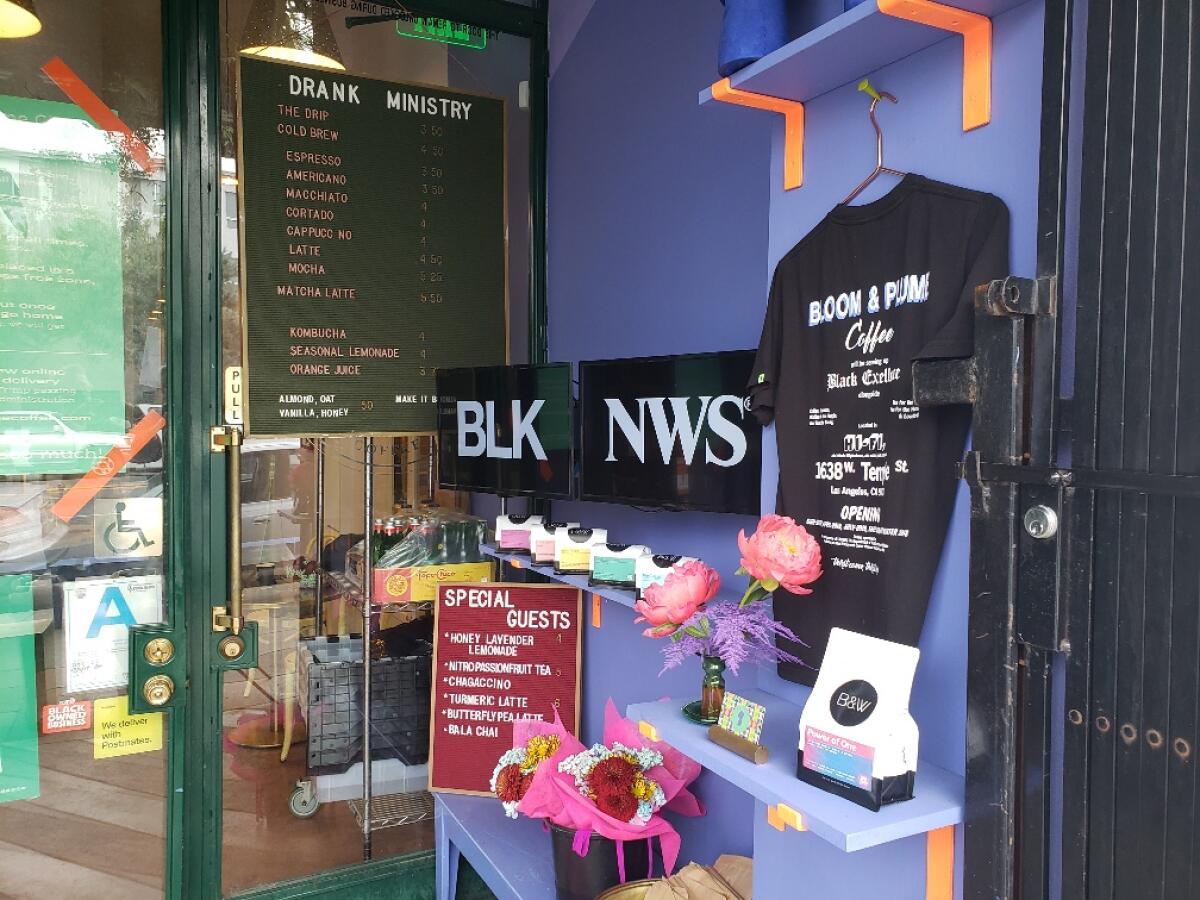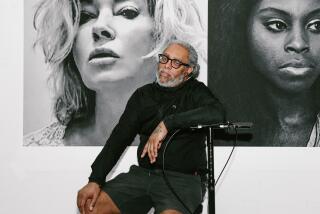Review: Whose news? Artist Kahlil Josephâs âBLKNWSÂŽâ delivers what CNN or Fox do not

News channels like CNN or Fox broadcast all day, every day, on television screens mounted in public places all across American life. At the doctorâs office, in an airport lounge, at a coffee shop â you name it, cable news is not just in your living room.
The programming tends to be loud, graphically and otherwise. It lands somewhere between an occasionally jolting dose of infotainment, sometimes useful and often not, and a visual and aural distraction serving dull commercial ends.
But not âBLKNWSÂŽ.â
Artist and filmmaker Kahlil Josephâs self-described âconceptual news program,â which he began producing in 2018, is different from the sleekly produced merchandise of corporate television. Yes, his can be noisy too, and the pace of his editing is quick. But the stories donât develop, they accrue. Josephâs programming is textured and eccentric, which is not the stuff of cable. The whole is bigger than the sum of its parts.
âBLKNWSÂŽâ is part of âMade in LA 2020: a version,â the latest installment of the UCLA Hammer Museumâs biennial survey of new art. Co-sponsored this year with the Huntington Library, Art Museum and Botanical Gardens in San Marino, the showâs run has been postponed by the COVID-19 pandemic. Originally scheduled for the summer months, it should be a receding memory by now.
Josephâs presentation was co-produced with Los Angeles Nomadic Division, which organizes site-specific public art exhibitions around the city. Nine venues host âBLKNWSÂŽ,â and the Hammer will become the 10th site when health restrictions that have kept the museum shuttered finally lift.
I visited four of them. Various mixes of the TV program are at each one, but perception of whatâs on-screen shifted a bit depending on the circumstance.
Each âBLKNWSÂŽâ installation consists of two side-by-side TVs. The format alone tells you that multiple rather than singular viewpoints are unfolding. A pair of looped video-montages is composed from an array of footage, virtually all of it on subjects of Black life, past and present.
Much of it is found material gleaned from documentary films, home movies, recorded bits of broadcast television, Hollywood epics, music videos, shots from family albums and more. These are interspersed with new material â selfies, neighborly interviews, aerial drone shots of the city edited into gloriously unfolding kaleidoscopes and other homemade clips.
Periodically, pictures abruptly stop and simple aphorisms and familiar slogans turn up printed across the screen in blunt, sans-serif type. âWe must rely on ourselves,â says one, while others promise âEmancipated spaceâ and âThe shape of things to come.â
Such unassuming notions arenât exactly news. But they do serve another worthy function. Each snippet of everyday text is accompanied by a declaration that the statement is âbrought to you by BLKNWSÂŽ.â The familiarity serves to bond a viewer with the artist and his images. Itâs Joseph being sociable.
Every now and then the logo for BLKNWSÂŽ pops in, interrupting the flow and spinning in digital space. Two anchors â one male, one female; one Black, one white â also turn up, both dressed in a casual uniform of black jacket and white shirt.
Alzo Slade is a stand-up comic who is also a correspondent for âVice News Tonight,â the Emmy award-winning nightly newscast. Helen Molesworth is an independent curator who organized a show of Josephâs two-channel video âm.A.A.d.â in 2015, when she worked at the Museum of Contemporary Art. The choice of a comic and a curator as nominal anchors is inspired.
Nothing much happens in âm.A.A.d.,â Kahlil Josephâs double-screen video installation at the Museum of Contemporary Art.
In this national election year, truth-telling has become a rare and exceptional gift for a society buried beneath an avalanche of lies. Comedy is funny when the ephemeral joke is built on a solid foundation of veracity. Picasso is purported to have described art as âa lie that tells the truth.â As anchors, the comic and the curator add ballast to the quotidian realities of Josephâs diverse clips.
One of the shops I visited to watch âBLKNWSÂŽâ was closed when I got there. (Not all the venues have posted hours.) Two others â the fashionable Bloom & Plume coffee shop in Historic Filipinotown and the venerable Jamaican restaurant Natraliart in West Adams â offered an amenable ambiance for masked and socially distanced customers waiting to pick up their orders.
In both, âBLKNWSÂŽâ slipped seamlessly inside the cityâs ebb and flow. A viewerâs daily experience merged with art being observed on the screens.
One drawback was that both shops also had music playing, which made the video soundtrack difficult to hear. (The visuals are still eye-catching.) Critic Hilton Als has called Joseph âa master of sound,â but youâd be hard-pressed to know it here.
That wasnât the case at my fourth (and favorite) stop.
Outdoor art thatâs part of the Hammer and the Huntingtonâs âMade in L.A. 2020â quietly pops up in public spots around the city. Hereâs where to look.
Hankâs Mini Market is in the Hyde Park section of South L.A., and itâs the most flatly beautiful neighborhood convenience store Iâve ever seen. (Founded by Henry Jackson nearly a quarter-century ago, it was recently re-envisioned by his daughter, artist Kelli Jackson.) The formal concept is simple: In a quintessentially clean, well-lighted place, baskets of fresh fruit and gleaming household products are lined up with acute precision on low shelves. Lush Pop artifacts are recast as rigorous Minimalist sculpture.
Mayonnaise, energy drinks and dishwashing liquid never looked so good.
Most convenience stores are organized for a speedy in-and-out (hence the name). This one also accomplishes that essential task. But itâs such a lovely, carefully considered space that one wants to linger. Like âBLKNWSÂŽ,â Hankâs plays against type.
Josephâs video screens hang by a shared table and chairs on an end wall that, in other times, sports a community bulletin board. No linear narrative â no beginning, middle and end â adheres to his âBLKNWSÂŽâ clips, which donât convey Black stories, history or style in a conventionally journalistic sense. Instead, like the collaged newspapers on a Cubist cafe table painted next to a cup of coffee or a glass of wine, they have other, more sociable things in mind. âBLKNWSÂŽâ invites contemplation, which is something CNN and Fox rarely summon.
Kahlil Joseph's 'BLKNWSÂŽ'
For a list of sites, go to or hammer.ucla.edu or nomadicdivision.org.
More to Read
The biggest entertainment stories
Get our big stories about Hollywood, film, television, music, arts, culture and more right in your inbox as soon as they publish.
You may occasionally receive promotional content from the Los Angeles Times.











